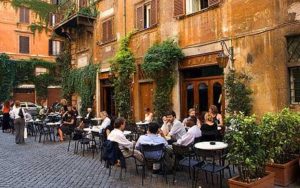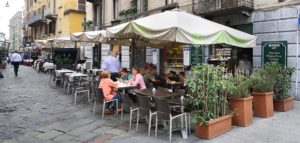Host and MET Bocconi Unveil the Role of Italian Hospitality
An industry made up of 325 thousand companies and a turnover worth € 51 billion
 Italians eat out always more often, over one-third of families’ food expenditure, about 35%, equal to € 75 billion. Unlike domestic consumption, these figures have remained stable throughout the crisis and have started to grow again in the past three years. All this reflects in the unique density of catering companies across Italy, which are over 325 thousand, more than half of which (53.1%) are restaurants but also mobile catering businesses, thereby confirming the increasing popularity of street food. Moreover, 64.3% of the latter sell food to the public, equal to approximately 111 thousand companies. Lombardy (15.4%) is the region with the highest concentration of restaurants, followed by Lazio (10.9%) and Campania (9.4%). Street food has the same podium: Lombardy (13.9%) followed by Lazio (11.3%) and Campania (9.3%). The out-of-home industry and Italian entrepreneurship in general are dominated by SMEs. The average number of employees is 5.6 for a total of 376 thousand employees (FIPE, 2016).
Italians eat out always more often, over one-third of families’ food expenditure, about 35%, equal to € 75 billion. Unlike domestic consumption, these figures have remained stable throughout the crisis and have started to grow again in the past three years. All this reflects in the unique density of catering companies across Italy, which are over 325 thousand, more than half of which (53.1%) are restaurants but also mobile catering businesses, thereby confirming the increasing popularity of street food. Moreover, 64.3% of the latter sell food to the public, equal to approximately 111 thousand companies. Lombardy (15.4%) is the region with the highest concentration of restaurants, followed by Lazio (10.9%) and Campania (9.4%). Street food has the same podium: Lombardy (13.9%) followed by Lazio (11.3%) and Campania (9.3%). The out-of-home industry and Italian entrepreneurship in general are dominated by SMEs. The average number of employees is 5.6 for a total of 376 thousand employees (FIPE, 2016).
In Europe, Italian hospitality plays a primary role. With approximately € 51 billion in 2014, of which 40% attributable to restaurants alone, Italian companies represent one-seventh of the turnover of the entire sector in EU-28 (375 billion) and over one-tenth of the added value (€ 18 billion out of 152), 37.4% due to restaurants. In Italy, there has been an overall growth of the sector in the period from 2008 to 2014. Estimates for 2015 foresee an additional 2.8% increase (calculations based on Eurostat data, 2016).
Unique experiences, conviviality, and sharing are the keywords for tomorrow’s catering industry
Research has also shown that the professional hospitality and food&beverage industries are moving towards premium segments as a result of increasingly aspirational consumption. The food, wine, and luxury liquor sectors have also been growing over the past few years, with a +4% increase between 2015 and 2016. However, it’s the hospitality sector that benefits most from this evolution, with an increasing number of excellent restaurants specialising in a niche targeting specific market segments. Over the past few years, unlike the direct sale of luxury food and wine, these segments have increased considerably. Of the € 45 billion turnover in the F&B sector, 46% refers to the restaurant industry (Bain & Company and Fondazione Altagamma, 2016).
 This evolution is not just quantitative. Even the most sought-after foods are changing: meat, salt, and butter are decreasing, while vegetables are on the rise. We are eating healthier and more veggies even in restaurants; however, we’re not giving up on more convivial dishes such as entrées and desserts any time soon. The social value of what we choose to eat and how we eat it is one of the constants emerging from the research (FIPE, 2017). And the way we choose where to eat is changing too. About nine Italians out of ten look for information on the Internet before going to a new location (24% always, 37.5% often, and 25.9% sometimes), whereas only 7.9% seldom and 4.6% never does. Online reviews also play a part in the choice. They are very important for 23.5%, quite important for 63.7% and not very important or not important at all for 12.8%. People mainly search for prices (69%), reviews (60.3%), and type of cuisine (59.9%). Opening hours and days (53.8%) and the location’s position (43.8%) are other details searched online. But the web is so much more than just a source of information. It’s also a place where to share experiences. The social aspect is increasingly relevant to enjoy conviviality: 61.1% likes to share for fun or the pleasure of doing so, whereas status is important for 28.2%, and 27.8% likes to share unusual aspects and experiences (TradeLab for Mixer, 2016).
This evolution is not just quantitative. Even the most sought-after foods are changing: meat, salt, and butter are decreasing, while vegetables are on the rise. We are eating healthier and more veggies even in restaurants; however, we’re not giving up on more convivial dishes such as entrées and desserts any time soon. The social value of what we choose to eat and how we eat it is one of the constants emerging from the research (FIPE, 2017). And the way we choose where to eat is changing too. About nine Italians out of ten look for information on the Internet before going to a new location (24% always, 37.5% often, and 25.9% sometimes), whereas only 7.9% seldom and 4.6% never does. Online reviews also play a part in the choice. They are very important for 23.5%, quite important for 63.7% and not very important or not important at all for 12.8%. People mainly search for prices (69%), reviews (60.3%), and type of cuisine (59.9%). Opening hours and days (53.8%) and the location’s position (43.8%) are other details searched online. But the web is so much more than just a source of information. It’s also a place where to share experiences. The social aspect is increasingly relevant to enjoy conviviality: 61.1% likes to share for fun or the pleasure of doing so, whereas status is important for 28.2%, and 27.8% likes to share unusual aspects and experiences (TradeLab for Mixer, 2016).
In this context, the human factor is central. The direct and often friendly relationship with restaurateurs is another “secret ingredient” in Italian style hospitality’s recipe for success. It also helps create that “unique experience” in which the client takes the centre stage, preferring conviviality in the leisure segment. A cosy environment and friendly staff are important for 81.6%. Table setting and dish presentation is the second most important factor (51.2%) – thereby confirming the Italian attitude in appreciating all things beautiful – followed by the interior design with 44.4% (TradeLab for Mixer, 2016).
(from the research: Ristorazione, lusso e territorio: Drivers dell’Italian way of living – Foodservice, luxury, and the territory: Drivers of the Italian way of living – promoted by HostMilano and conducted by Magda Antonioli Corigliano, the director of the Master in Tourism Economics of the Bocconi University, and MET Bocconi researcher Sara Bricchi)



